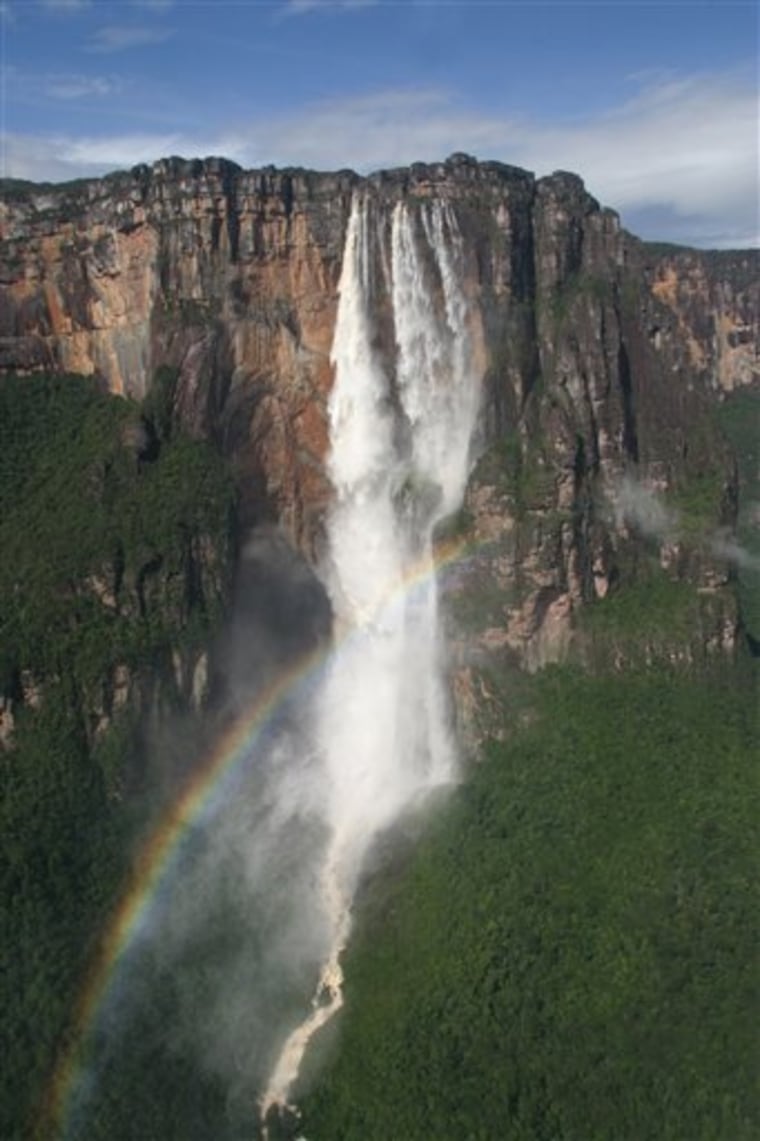CHIMANTA TEPUI, Venezuela — Charles Brewer Carias has discovered giant sinkholes, collected new species of plants and scorpions, and rappelled into unexplored caves on his nearly 200 expeditions into the flat-topped mountains and jungles of Venezuela.
The mustachioed 68-year-old says his passion for discovery makes him a throwback to the 19th century explorers who once trekked through South America. And he has found his modern-day Eden among the sandstone plateaus of Venezuela, known as "tepuis," which tower above rain forests and savannas.
Brewer has spent much of his life learning to spot subtle anomalies in this rugged landscape, which is home to Angel Falls — the world's tallest waterfall — and was the setting of Arthur Conan Doyle's famous dinosaur novel "The Lost World."
"The idea of discovery is to see things that no one has seen before," says Brewer, who calls the tepuis "islands in time," each of them isolated much like the Galapagos Islands, allowing evolution to run its distinct course on every mountaintop.
His knowledge and keen abilities of observation have made Brewer the best-known explorer and naturalist in Venezuela.
Flying by helicopter, he gazes down at the tepuis searching for changes in vegetation, rivers disappearing into holes or other clues that could point to a landing spot for his next expedition.
This time he is headed to the site of one of his grandest discoveries: a giant quartzite cave in the belly of a plateau, which he is exploring with the help of scientists from Slovakia and Croatia.
Five years ago, he spotted a river emerging from this cave while flying past. He returned with a team to hike into it, and found what experts believe to be the world's biggest quartzite cave. The group named it after Brewer.
Measured at nearly 4.5 kilometers (2.8 miles) long, the cave runs along a river through chambers at times up to 40 meters (130 feet) high. The explorers pause to examine amphibious crickets, rare scorpions and odd mineral deposits called speleothems that grow like coral reefs from the cave floor.
"That's a beautiful piece," Brewer exclaims, squatting to photograph one of the chalky opal speleothems, which scientists believe are built up by bacteria over time.
A total of 22 species _ plants, reptiles, insects and a scorpion _ have been named in Brewer's honor, including an entirely new genus of bromeliad, with glossy leaves and white flowers, which he found in 1981.
He also has explored underwater, leading a 1998 scuba expedition to a sunken fleet of 17th-century French ships off Venezuela's Las Aves Islands.
Some scientists accuse Brewer of excessively seeking credit and attention for discoveries.
But he sees a simple reason for their complaints: "Jealousy, sheer jealousy."
Brewer has long been captivated by Sir Walter Raleigh's writings about his travels in Venezuela more than 400 years ago. And citing stories related by Raleigh, Brewer is convinced that the lost city of El Dorado, named after an Indian headman who covered himself in gold dust, remains hidden in Venezuela's jungles.
He hopes to prove it by returning to explore a site in the Amazon where in 1990 he unearthed a find of pottery shards, made of clay mixed with gold dust.
Brewer, the grandson of a British diplomat who married a Venezuelan, has always been fascinated by subjects from botany to anthropology. While growing up in Caracas, his father urged him to specialize, so Brewer became a dentist like his dad.
But he soon gravitated to broader interests. In 1961, he went to live with the Yekuana Indians, performing dental anthropological studies and learning their language. He did similar work among the isolated Yanomami Indians.
The author Patrick Tierney takes a critical view of Brewer in his book "Darkness in El Dorado," accusing him of clandestine gold mining and saying repeated expeditions involving him, scientists and journalists were harmful to the Yanomami.
Brewer calls them false accusations prompted in part by his own complaints that Catholic missionaries have harmed the Indians. He acknowledges trying to get involved in gold mining elsewhere but says he gave up because he couldn't obtain permits.
Instead, he has excelled at other pursuits. He designed his own survival knife, gathered rare plants for collections and published eight books with photographs taken during his forays.
The government used to support his expeditions, but today he struggles to obtain funding and asks scientists to pay their own way on rented helicopters.
Brewer, who has five children from two marriages, sometimes regrets his decision in 1978 to give up dentistry _ and the financial security it brought.
His most harrowing experience came when he was shot during a 2003 burglary. Wounded in the shoulder, he shot and killed one of the intruders. Bullet fragments remain lodged in his shoulder, but he has not let the injury limit him on outings, boasting he can go for long periods without food or water and still swim faster than most men half his age.
His boyish enthusiasm shows as he collects ferns and flowers outside the cave, reciting their Latin names as he presses them into his log book.
"You have to have a childish, inquisitive nature," he says. "I'm discovering new caves, places where people never imagined before. I'm getting answers where no one ever asked questions before."
